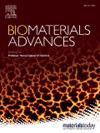乌贼骨启发的“S”型沟槽拓扑结构通过Rap1-ERK途径促进成骨分化
IF 6
2区 医学
Q2 MATERIALS SCIENCE, BIOMATERIALS
Materials Science & Engineering C-Materials for Biological Applications
Pub Date : 2025-07-23
DOI:10.1016/j.bioadv.2025.214431
引用次数: 0
摘要
虽然生物材料拓扑结构在骨再生中的调节作用已被认识到,但由不同形态特征驱动的特定成骨机制,特别是在没有生化线索的情况下,仍然知之甚少。本研究旨在独立阐明海螵蛸独特的“S”型沟槽拓扑结构的成骨潜力和潜在机制。受海螵蛸的启发,我们利用液态硅模复制技术结合PCL重铸技术,成功地制造了具有“S”形拓扑结构的仿生聚己内酯(PCL)膜片。综合表征(SEM, CLSM)证实了原始“S”型沟槽形态(宽度:100±30 μm,深度:20±6 μm)的精确复制。体外研究表明,这些沟槽通过接触引导促进大鼠骨髓间充质干细胞(rBMSCs)的定向粘附和增殖,细胞骨架排列证明了这一点。此外,“S”型沟槽拓扑结构显著增强小鼠前成骨细胞(MC3T3-E1)的成骨分化,表现为碱性磷酸酶(ALP)活性增加和矿化结节形成。利用RT-qPCR、Western blot和基于二甲基标记的rBMSCs定量蛋白质组学的机制研究确定了Rap1-ERK信号通路的关键参与。具体来说,“S”型沟槽拓扑上调Rap1表达,增强ERK磷酸化,导致成骨标志物(如Runx2、OPN)表达增加。这些研究结果表明,仅采用仿生“S”型沟槽拓扑结构,通过接触引导和激活Rap1-ERK机械转导通路,就能显著增强成骨分化,为设计具有“S”型沟槽拓扑结构的骨再生仿生PCL膜片的拓扑优化生物材料奠定了基础。本文章由计算机程序翻译,如有差异,请以英文原文为准。
Cuttlebone inspired “S”-grooved topological structures facilitate osteogenic differentiation through the Rap1-ERK pathway
While the regulatory roles of biomaterial topology in bone regeneration are recognized, the specific osteogenic mechanisms driven by distinct morphological features, particularly without biochemical cues, remain poorly understood. This study aimed to independently elucidate the osteogenic potential and underlying mechanisms solely attributable to the distinctive “S”-grooved topology derived from cuttlebone. Inspired by cuttlebone, we successfully fabricated a biomimetic polycaprolactone (PCL) membranes sheet with “S”-grooved topology using liquid silicone mold replication combined with PCL recasting techniques. Comprehensive characterization (SEM, CLSM) confirmed precise replication of the native “S”-grooved morphology (width: 100 ± 30 μm, depth: 20 ± 6 μm). In vitro studies revealed that these grooves promoted directional adhesion and proliferation of rat bone marrow mesenchymal stem cells (rBMSCs) via contact guidance, as evidenced by cytoskeleton alignment. Furthermore, the “S”-grooved topology significantly enhanced osteogenic differentiation of mouse pre-osteoblasts (MC3T3-E1), demonstrated by increased alkaline phosphatase (ALP) activity and mineralized nodule formation. Mechanistic investigations using RT-qPCR, Western blot, and dimethyl labeling-based quantitative proteomics on rBMSCs identified key involvement of the Rap1-ERK signaling pathway. Specifically, the “S”-grooved topology upregulated Rap1 expression and enhanced ERK phosphorylation, leading to increased expression of osteogenic markers (e.g., Runx2, OPN). These findings demonstrate that the biomimetic “S”-grooved topology alone, through contact guidance and activation of the Rap1-ERK mechanotransduction pathway, significantly enhances osteogenic differentiation, providing a foundation for designing topologically optimized biomaterials for bone regeneration biomimetic PCL membranes sheet with the “S”-grooved topology.
求助全文
通过发布文献求助,成功后即可免费获取论文全文。
去求助
来源期刊
CiteScore
17.80
自引率
0.00%
发文量
501
审稿时长
27 days
期刊介绍:
Biomaterials Advances, previously known as Materials Science and Engineering: C-Materials for Biological Applications (P-ISSN: 0928-4931, E-ISSN: 1873-0191). Includes topics at the interface of the biomedical sciences and materials engineering. These topics include:
• Bioinspired and biomimetic materials for medical applications
• Materials of biological origin for medical applications
• Materials for "active" medical applications
• Self-assembling and self-healing materials for medical applications
• "Smart" (i.e., stimulus-response) materials for medical applications
• Ceramic, metallic, polymeric, and composite materials for medical applications
• Materials for in vivo sensing
• Materials for in vivo imaging
• Materials for delivery of pharmacologic agents and vaccines
• Novel approaches for characterizing and modeling materials for medical applications
Manuscripts on biological topics without a materials science component, or manuscripts on materials science without biological applications, will not be considered for publication in Materials Science and Engineering C. New submissions are first assessed for language, scope and originality (plagiarism check) and can be desk rejected before review if they need English language improvements, are out of scope or present excessive duplication with published sources.
Biomaterials Advances sits within Elsevier''s biomaterials science portfolio alongside Biomaterials, Materials Today Bio and Biomaterials and Biosystems. As part of the broader Materials Today family, Biomaterials Advances offers authors rigorous peer review, rapid decisions, and high visibility. We look forward to receiving your submissions!

 求助内容:
求助内容: 应助结果提醒方式:
应助结果提醒方式:


